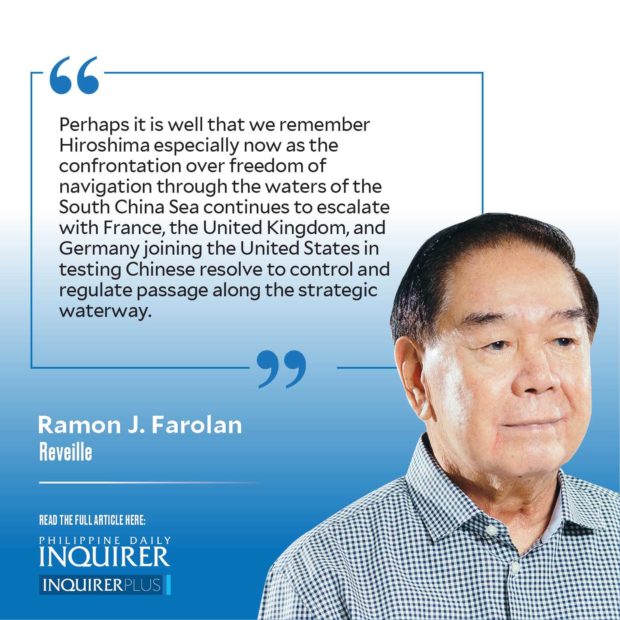
Last Friday was the 76th anniversary of the atomic bombing of Hiroshima. With the Tokyo Olympics in full swing amidst a raging pandemic, few wanted to be reminded of an event that took the lives of more than 130,000 people, plus countless others who suffered from thermal burns, shock, and radioactive poisoning.
But perhaps it is well that we remember Hiroshima especially now as the confrontation over freedom of navigation through the waters of the South China Sea continues to escalate with France, the United Kingdom, and Germany joining the United States in testing Chinese resolve to control and regulate passage along the strategic waterway. A slight miscalculation, a mistaken encounter, aggressive action by an emotionally unbalanced pilot or ship commander, could easily trigger the release of nuclear warheads in an immediate response by the opposing forces. Once started, it would be almost impossible to bring about a ceasefire.
In 1945, a Gallup Poll indicated that older Americans had no problem with the use of the Bomb on Hiroshima. But for those under the age of 30, there appeared to be some concern and regret. Had the same survey been carried out among Filipinos, perhaps the same division of sentiments would have been reflected. Those who suffered from or witnessed the cruelty of Japanese occupation — and I would include myself in this group — would have had no second thoughts about the use of the Bomb while those born after the war would probably be more concerned about the morality issue.
Any discussion about Hiroshima would probably be more fruitful and enlightening if we take into account what the decision-makers at that time were facing and thinking. The fellow who made the decision to drop the Bomb was the “Man from Missouri,” President Harry S. Truman. He said that next to committing American combat troops in Korea, the most difficult decision of his presidency was the decision to use the atomic bomb. The decision may have been difficult but there was never any doubt as to the use of the Bomb. It was just another military weapon and if it could stop the war and save American lives that would be sacrificed in an invasion of Japan, it was going to be used. The estimate for casualties in the invasion of the Japanese mainland was placed at a quarter-of-a-million allied soldiers, including Filipinos that were being trained for such an operation.
Charles Bohlen, a former US ambassador to the Philippines, once wrote that “the spirit of mercy was not throbbing in the breast of any allied official, either for the Germans or the Japanese.” To the American people, the Japanese were the perpetrators of the infamous Pearl Harbor attack, the Bataan Death March, the butchers of civilians in the fight for Manila. They had spent close to $2 billion on the secret Manhattan Project to develop the Bomb, and they were certainly not going to see their investment go to waste.
In early 1945, a Target Committee was created to decide on which city to drop the Bomb. By May, the selection process had zeroed in on five cities: (1) Kyoto; (2) Hiroshima; (3) Yokohama; (4) Kokura; and (5) Niigata. At this point, Secretary of War Henry Stimson, when informed that Kyoto was at the top of the list, decided to remove the city as a target. As governor general of the Philippines, he had visited Kyoto and was much impressed by it ancient culture and religious significance to the Japanese. Hiroshima became the primary target and Nagasaki was included in the list, replacing Kyoto. Surprisingly, Hiroshima had special relations with the United States. In 1899, large waves of Japanese immigrants left for the United States to work on Hawaiian plantations. Almost one-third came from Hiroshima and so many of the city residents had relatives in the United States.
By the end of July, Special Bombing Mission No. 13 was activated with Col. Paul W. Tibbets, Jr. selected to carry out this most dangerous and delicate mission. His B-29 bomber plane was christened “Enola Gay,” after his mother’s first and middle names. In the early morning hours of Aug. 6, 1945, 12 crewmembers boarded Enola Gay and took off from a base in Tinian, in the Marianas Islands. The Bomb, dubbed “Little Boy,” was already in the belly of the plane.
For Filipinos, the Japanese had done their worst in Bataan, murdering more than 300 Filipino officers and men who had surrendered, and in the Battle of Manila where women and children were massacred. Hiroshima and Nagasaki were divine methods for the settlement of accounts.